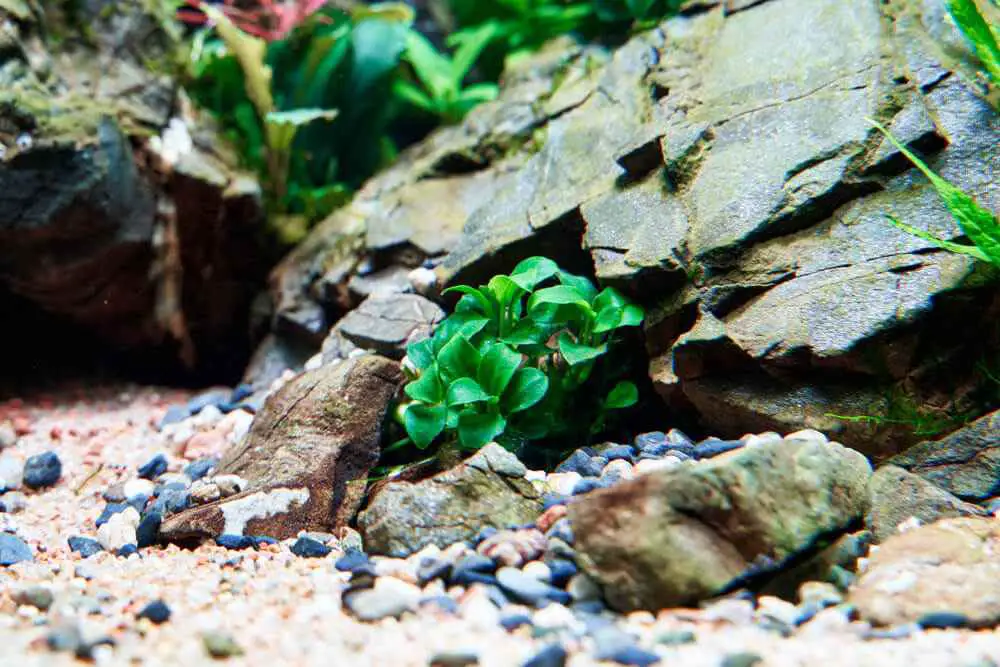When caring for aquarium plants, it’s important to know what conditions are best for them, but also what you can do if something goes wrong. Moreover, it’s also essential to know the difference between a plant that just needs recovery time, or a plant that may need to be taken out.
An Anubias plant is an aquatic plant with a rhizome, which means that it will survive as long as the long, horizontal runner beneath the surface is thriving, even if all the leaves are removed or fall off.
For more about Anubias plant care, read on.
Can Anubias Plants Survive Without Leaves?
Anubias, like many aquatic and semi-aquatic plants, can actually survive, even grow, without its leaves. Leaves will help the plant get the nutrients and light it needs to thrive, but losing all its leaves won’t kill this plant.
As long as the long thready root-like growth at the base is happy, even a leafless Anubias has a fighting chance.
What Does An Anubias Need to Survive?
All an Anubias really needs to survive is a thriving rhizome stem. As long as the rhizome is healthy, new shoots, stems and leaves will sprout with time.
The rhizome is a long root-like stem that grows underground for many aquatic and semi-aquatic plants.
As it grows it expands the underground network of the plant, and allows for new shoots and new growth, even if all of the previous growth has been broken off or damaged.
Related Guides: Anubias Light Requirement | Anubias Fertilizer Requirement
How Does An Anubias Grow Without Leaves?
The rhizome, or the long root-like stem that grows horizontally underneath the leafy part of the plant can survive even if the leaves and visible stems are removed.
Healthy rhizomes can reproduce on their own. Healthy rhizomes will reproduce and expand the root system of the plant on their own. They’ll also produce buds to sprout into new shoots and leaves.
How Can You Tell If An Anubias Is Dying Or Not When There Are No Leaves?
The best way to determine the health of an Anubias, if there are no leaves visible, is to check the rhizomes.
If you want to check the health of a leafless Anubias plant, carefully take them from where they’re planted, and check the rhizomes
Healthy rhizomes, once cleaned of dirt and vegetation, should be flexible. They should also be a pale tan or whitish color.
Darker brown rhizomes, brittle rhizomes, or rhizomes with a crumbly outer sheath are unhealthy, and need to be taken care of to restore them to full health.
Why Do Anubias Lose Their Leaves?
There are a lot of reasons why an Anubias might lose their leaves. Some of it is perfectly normal, especially for recently planted or transplanted Anubias plants.
When you notice a lot of leaves coming off, consider the following:
- Was the plant recently transplanted?
- is the plant adjusting to a submersive (entirely underwater) or emersive (leaves and shoots above the water’s surface) environment?
- Do the water conditions need to be adjusted, or have they been adjusted recently?
- Is the tank too crowded for the Anubias?
All of these can be the cause of lost leaves, and they’re fairly easy to correct with a little care.
What If The Problem Isn’t Adjusting To Tank Conditions?
If the Anubias is losing leaves and it doesn’t seem to be an environmental issue, you might want to check and make sure it’s not Anubias Rot.
If this is the problem, then there will be signs. The first is leaves that detach from a soft or ‘squishy’ stem, or leaves that drop off in large quantities.
The stems, roots and rhizomes will also be pulpy and may even feel or look gooey. This is called ‘melting‘, for the appearance it gives the plant and leaves.
Suggested Read: How Long Can Anubias Be Out Of Water?
What Should I Do If My Anubias Has Anubias Rot?
Trim away all affected areas of the plant, including roots, rhizomes, shoots and leaves.
Find a healthy rhizome if possible, and transplant it to a place where it can begin the process of regrowing.
You’ll also want to make sure the condition hasn’t spread to any other Anubias plants in your tank. The sooner it’s caught, the better chances your plants have of recovery.
Would You Ever Want to Trim Or Remove Anubias Leaves?
If there are signs that the leaves are blighted, dying off, or melting, then you might want to remove them to preserve the health and appearance of the plant.
An Anubias can regrow leaves and stems with a healthy rhizome, but if a problem spreads from the leaves to the rhizome, the plant may become unsalvageable.
Is There a Way To Tell If An Anubias Is About to Lose Leaves?
The leaves may be loose on the stems, or they may be yellowing in color. They might also droop or be less vibrant than the leaves around him.
If you’re uncertain about it, you can try tugging gently on the leaves.
Healthy leaves will be firmly attached.
How Can You Help An Anubias Recover?
Trim affected areas, and remove damaged sections in the plant. Then make sure all conditions are as close to optimum as possible.
Include:
- Proper water and temperature
- An emersive environment (Anubias prefer this to submersive)
- Proper planting surface: They prefer rocky areas or driftwood to wrap their roots and rhizomes around.
How Long Should It Take New Leaves to Grow On a Healthy Anubias?
Healthy Anubias plants tend to grow new leaves every two weeks, when they’re at peak health and peak conditions.
Even outside peak conditions, Anubias should be producing new growth every 4 to 6 weeks. Less than that, or if your Anubias is losing leaves faster than the regrowth, you may want to check the overall health of the plant.
Final Thoughts:
While a healthy Anubias plant should have plenty of leafy green growth, it can certainly survive a loss of leaves. Even if all the leaves are removed or fall off for some reason, an Anubias plant can survive and thrive.
All you really need for your Anubias to survive and grow again is a thriving rhizome, and the rest will recover with time.
Read Next: Why Are Anubias So Expensive?
Hi! I’m Praveen Ghoshal, the founder of eFishkeeping.com. Inspired by my Dad, I got interested in fishkeeping when I was a kid. Since then, I have been involved with this hobby. Currently, I have 3 fish tanks at our home, and I enjoy this hobby with my full family. Read more about me here.


![Why Are Anubias So Expensive? [Reasons + Cheap Alternatives] why-are-anubias-so-expensive](https://efishkeeping.com/wp-content/uploads/2022/12/anubias-in-a-planted-aquarium-300x200.jpg)
![Anubias Has Holes In Leaves? [Top 5 Causes And Solutions] anubias-has-holes-in-leaves](https://efishkeeping.com/wp-content/uploads/2023/04/anubias-has-holes-in-leaves-300x202.jpg)



